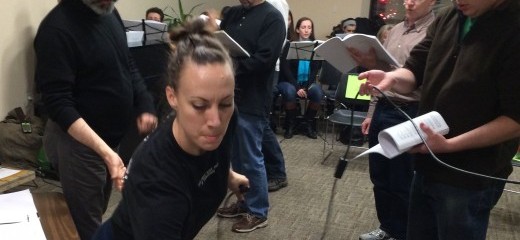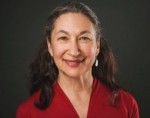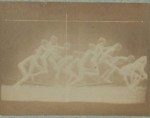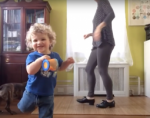
Photo: Michael Mills
A Dancing, Songful Farewell
by Lynn Matluck Brooks
The Radio Hour, a one-act opera composed by Jake Heggie with a libretto by Gene Scheer, is very much about time. The rehearsal I watched for the Philadelphia Singers’ production features a retro cabinet radio along with a lead performer checking her cell phone, swing music juxtaposed with rap, and a new opera performed by a 43-year old Philadelphia cultural institution
in its very last season.
Directed by dancer-choreographer
Seán Curran, this “choral opera,” as the press release describes it, will be performed Friday and Saturday, March 27
th and 28
th, at the Temple Performing Arts Center. I spoke recently with Curran and dancer Elizabeth Coker during a rehearsal break, after I observed the work come increasingly to musical and movement life over the course of the preceding two hours.
Curran, who grew up listening to the radio and still enjoys it, tells the “implied narrative” of the opera through movement: a young woman, Nora, comes home, lonely in her apartment after an apparent break-up. She turns on her radio and soon finds its channels telling her own story back to her. At times she flows with it, at others, she fears it, and I wonder if she is dreaming or living in some other altered state. The work had its premiere last May, by the John Alexander Singers in Costa Mesa, California, with the lead character played by an actress; but Curran saw Nora as a dancer, a figure particularly suited to his long-time collaborator
Elizabeth Coker, who is dancing the role with the Philadelphia Singers.
The choreographer came to the project through his work choreographing Oscar (music by Theodore Morrison) for Opera Philadelphia last month. He’s fallen in love with Philly, and like so many others, feels deeply saddened at this tear in the city’s cultural fabric left by the impending demise of the Philadelphia Singers.
Curran’s background well prepares him for the blending of music, dance, and drama that The Radio Hour demands; he started dance with Irish clogging, performed in Stomp, directed operas from San Francisco to the Met, and has even taken on that most musical of playwrights, Shakespeare. He also danced with Bill T. Jones/Arnie Zane, a big-vision, high-narrative company. While Curran likes staging that “moves big,” he also appreciates the negotiation with singers that his work demands, resulting in “simple, direct, elegant, streamlined” movement.
As I watched him paint the rehearsal hall’s stage with movement, the good-natured and beautiful-voiced singers energetically stamped and clapped, swayed and pivoted, formed archways and bridges, stood up and sat down, and marched through the room, bringing Nora’s story to life with (and for) her. Although dancing on a carpet, in a much-restricted space, Coker moved eloquently through emotional textures and moody transitions: she was that lonely woman, not an only dancer.
How does a director put together a work of such complexity? The Philadelphia Singers are directed by long-term leader
David Hayes, with staging supported by
Jarrod Markman and dramaturg Richard Gammon, who offers big-picture feedback. Curran and Coker worked on the dance portions, apart from the singers, in New York. The five hours of rehearsal I viewed brought together these well-wrought components of the work to yield what will be a funny, stirring, and richly textured Philadelphia debut.
Along with The Radio Hour, the Philadelphia Singers will also present Gian Carlo Menotti’s The Unicorn, The Gorgon, and the Manticore, described as a “madrigal fable,” in an evening of “Myths and Magic: The Voices of Storytelling.” The preview of The Radio Hour shows promise, indeed, for the making of magic.
The Radio Hour, The Philadelphia Singers, Temple Performing Arts Center, 1837 N. Broad Street, March 27-28, www.philadelphiasingers.org.
By Lynn Matluck Brooks
March 24, 2015







.png)


